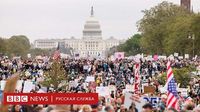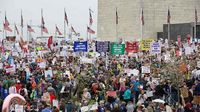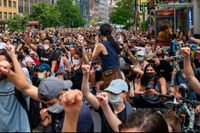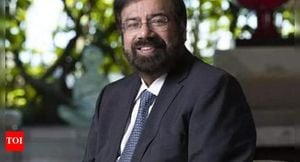Massive demonstrations erupted across the United States on Saturday, April 5, 2025, as citizens voiced their discontent with President Donald Trump's policies. Under the banner of the "Hands Off!" initiative, approximately 1,200 protests took place in all 50 states, with significant participation also noted in Canada, Germany, Mexico, and other nations. Reports indicate that over 20,000 people gathered in Washington alone, reflecting a widespread call for change.
Organized by more than 150 groups, including civil rights associations, trade unions, veteran organizations, and political activists, these protests were largely peaceful, with no arrests reported. Demonstrators expressed their frustration over cuts to federal funding, reductions in the number of civil servants, and significant cuts to healthcare programs. Many Americans fear that Trump will disregard his promises regarding social funding, further exacerbating existing issues.
The protests were not just limited to political grievances; they also highlighted concerns over immigration policies and the deportation of migrants. Among the crowds were representatives from national minorities, who expressed their anger over the administration's stance on immigration. As one protester stated, "I came to protest against everything the White House is doing, from immigration policies to the tariffs introduced this week on imports." This sentiment resonated deeply among the demonstrators, many of whom carried signs that read "Hands Off Our Democracy" and "Equal Inclusion Makes America Strong."
In Washington, prominent Democratic lawmakers took to the stage to voice their opposition to Trump’s policies. Congressman Maxwell Frost from Florida criticized the influence of wealthy donors, particularly Ilon Musk, on government decisions. He remarked, "When you steal from the people, expect the people to rise up. At the ballot box and in the streets." This rhetoric underscored the growing tension between the administration and its critics.
While the protests unfolded, President Trump spent the day at his golf club in Mar-a-Lago, Florida, a choice that many interpreted as a stark contrast to the issues at hand. Trump’s absence from the public eye during such a pivotal moment drew criticism, especially as he planned to continue his golfing activities on Sunday as well.
The protests were sparked in part by Trump's announcement of increased tariffs on imported goods, which he declared on April 2. The tariffs were set to rise to 10% on most imports, with European goods facing a 20% duty and Chinese goods a staggering 34%. This move drew immediate backlash, not only from American citizens but also from international observers, leading to solidarity demonstrations in cities like London, Paris, and Berlin.
In Boston, thousands of protesters gathered, holding signs and chanting slogans against the proposed tariffs and other policies they deemed harmful. Similar gatherings were reported in major cities like New York, Chicago, and Los Angeles, where the atmosphere was charged with a mix of hope and frustration.
Despite the scale of the demonstrations, some officials downplayed their significance. Tom Homan, head of immigration policy at ICE, dismissed the protesters' concerns in an interview with Fox News, stating, "They can protest at an empty house as much as they want… Protests and rallies mean nothing. So let them go and exercise their rights under the First Amendment. It won't change anything." His remarks reflect a broader sentiment among some in the administration, who view the protests as a nuisance rather than a legitimate expression of public sentiment.
The response from the White House was equally dismissive, with officials asserting that Trump's position remains clear: he will always protect social security and medical care for eligible beneficiaries. They further criticized Democrats for allegedly prioritizing benefits for illegal immigrants, claiming that such actions could lead to the bankruptcy of federal programs.
As the protests continued, many participants expressed a sense of urgency and determination. The actions were described as the largest nationwide protests since Trump took office, signaling a potential shift in the political landscape as citizens mobilize against policies they see as detrimental to their rights and well-being.
With the atmosphere thick with emotion, protesters carried a variety of flags, including Ukrainian flags and Palestinian scarves, symbolizing solidarity with global movements for justice and equality. This blend of local and global concerns highlighted the interconnectedness of issues facing Americans today.
As the weekend unfolded, the protests not only served as a platform for dissent but also as a reminder of the enduring power of civic engagement. Many participants left the rallies with renewed hope, believing that their voices could influence change in a political climate that often feels unresponsive to the needs of the people.
Looking ahead, it remains to be seen how the Trump administration will respond to this unprecedented wave of protests and whether the growing discontent will translate into significant political change. The upcoming weeks could prove crucial as activists continue to organize and mobilize, keeping the pressure on lawmakers to reconsider their policies.







